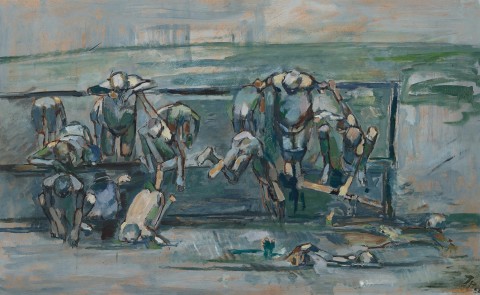BATHERS, 1952
JOHN PASSMORE
oil on composition board
56.0 x 90.0 cm
signed and dated lower right: JP 52
signed verso: J Passmore
Macquarie Galleries, Sydney
Private collection, Melbourne, acquired from the above c.1952
possibly: Sydney Painting 1952, Macquarie Galleries at Finney’s Gallery, Brisbane, 15 – 25 July 1952, cat. 46 (Bathers, 20gns)
The Bathers, 1951, oil on composition board, 91.0 x 183.0 cm, private collection, New South Wales
For me, a visit to the Art Gallery of New South Wales was never complete without a quick look at the group of John Passmore works, which occupied a small corner there for many years. This modest group of paintings dating from the early 1950s, bearing titles such as If you Don’t Believe me, Ask the Old Bloke, The Argument and The Fish Stealer, was a beautifully observed, perfectly weighted collection of pictures drawn from seaside life. Set amongst Passmore’s energetic brushwork, the swimmers jostle and cavort as they leap, fall or are pushed from the jetty. They are scenes of hilarity, with each work becoming the epitome of anecdote in paint.
Bathers, 1952, is a major example of Passmore’s painting, which would fit perfectly amongst the group belonging to the Art Gallery of New South Wales. These delicately tuned compositions, poised precisely between chaos and order, successfully evoke the playful atmosphere, mood and energy of the entire activity, rather than merely depicting one aspect of the scene.
The paintings featuring wharves and jetties had their genesis during the artist’s time teaching at the Newcastle Technical College. He had a room above the Star Hotel, near the College, where he also kept a studio. He also had a strong work ethic and lived frugally without distraction, an approach which enabled him to immerse himself in his painting, and which partly explains why works from this period are so consistent and focused in their execution. Around Newcastle he would spend weekends at seaside spots, observing the locals before returning to the studio and drawing obsessively before developing the sketches into paintings. Because the works were not painted en plein air, they are not tethered to the subject and therefore, with more than a nod to impressionism, deliver us a truer, more cinematic representation of the subject.
On his return to Sydney, Passmore became the torch-bearer for progressive painting through his teaching role at the National Art School. He was a natural teacher; his wit and enthusiasm inspired his students to look beyond the academic brown paintings of the day. A gaggle of devoted students (most notably John Olsen) hung on his every word, savoured his humour and indulged his habit of uttering Delphic maxims. His passion for Tintoretto and Rembrandt was front and centre, but it was Cézanne whose influence gripped the artist early and wove its way through his entire oeuvre. Passmore also helped to rekindle an earlier abstract art movement, which had flickered out during the Second World War. The earlier generation of abstract painters were formal and analytical, combining bright colour with geometry. In contrast, Passmore’s approach was freewheeling, lyrical and expressive.
Today he is remembered as an elfin-like guru, whose indelible influence lives on through generations of lyrical abstract painters. Murray Bail, writing for Passmore’s 1984-85 retrospective at the Art Gallery of New South Wales remembers, ‘Gradually over time everything fell away, even his Christian name. Unlike Arthur, Lloyd, Sid, Fred … he became known simply as Passmore. It seemed entirely appropriate, fitting the fact of his isolated shape which had become smaller and tighter. Passmore himself referred to himself as Passmore’.1 ‘Guard what is yours’ and ‘nothing in excess’ are two of his Delphic maxims that provide a small portal into Passmore’s approach to art and life.
1. Bail, M., ‘Passmore’s Isolation’, addendum to Pearce, B., John Passmore 1904 – 84, Retrospective, Art Gallery New South Wales, Sydney 1985
HENRY MULHOLLAND
